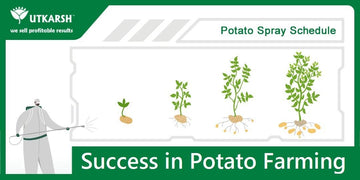
Production of Lentil in India -Introduction
Lentils are a type of pulses like red lentils, moong, yellow gram, split chickpea, pigeon peas etc. They are India’s second most important Rabi crop after chickpeas (they are sown in winter and harvested in spring). In India, lentil cultivation covers roughly 1.5 million hectares of arable land, but each hectare produces between 847 and 1000 kilograms of lentils, significantly lower than the global average of 1260 kilograms.
Among the states that are involved in lentil production in India are Madhya Pradesh, Uttar Pradesh, Bihar, Chattisgarh, Haryana, Punjab, Maharashtra, and Rajasthan, among others.
To increase Lentil production by 40% following are the basic requirement for profitable lentil farming:
Climatic conditions requirements
The lentil crop is generally grown in cool climates and is highly susceptible to rising temperatures. It is hardy and can withstand extreme weather conditions such as frost and severe winters.
In order to grow, it needs cold temperatures during its vegetative phase and warm temperatures during maturity. It grows best at temperatures ranging from 18 to 300 degrees Celsius. Their cultivation range extends up to 3,500 meters in the northwest hills.
Soil conditions requirements and field preparation
To increase lentil production, cultivation should be carried out on well-drained, loam soils with neutral reactions. The soil should be friable and weed-free so that seeding can be done at a uniform depth. Soils with acidic reactions are not suitable for lentil cultivation.
Land preparation:
For preparing land minimum tillage method is used which involves plowing twice the field.
As soon as fertilizers+ FYM has been applied to the soil, sow the seeds and do one planking after sowing the seeds to check the loss of soil moisture. Minimal tillage reduces cultivation costs and conserves natural resources.
Sowing
To propagate lentils, they are sown in rows 30 cm apart and at a lower depth (3 or 4 cm). To do this, either a Ferti-seed drill or a desi plough can be used.
Sowing time: The best time for rainfed production is the first fortnight of October in Central and South India and the second fortnight of October in North India.
Under irrigated conditions – In North India, the first two weeks of November are irrigated.
Late sowing: First week of December in NEPZ rice fallows or fields deserted late by kharif crops under irrigated conditions.
Manuring and fertilization
- If you are sowing on medium to low fertile soil, use compost or FYM@ 1-2 t/acre no later than 15 days before sowing and sulfur at 8 kg. per acre for the basal dressing of medium to low fertile soils.
- If the soil is low in Zn, foliar spray of 2% urea with 8 kg Zinc Sulphate is recommended under rainfall conditions and late sowing.
-
IrrigationTo increase lentil production, keep this in mind that excess water in lentil crops can eventually cause problems, such as delayed maturation, disease, and reduced yields. Lentils can’t tolerate waterlogged soils and will die in excess water. The lentil is typically a dryland crop, but it can be grown as an irrigation crop with careful water management.
-
For proper irrigation to increase lentil production:
- After planting, your first irrigation should be given about 40-45 days after planting and
- your second should be applied when your pods are full. Pod formation is the most important stage to avoid moisture stress followed by flower initiation.
Specially, in central India when winter rains do not occur and soil moisture is negligible two light irrigation is applied for yield improvement.

-
Pest and their controlling measure
- Cowpea Aphid
The cowpea aphid is black with white and black legs; it is a phloem feeder and injects toxins into the plant, which reduces vigour and yields. Also, aphid feeding causes honeydew to form, which is responsible for the growth of sooty mould that reduces photosynthesis and makes harvesting more difficult.
- Controlling measures:
To protect susceptible crops, spray with Neem Oil 3000 ppm @ 2ml/1, or use systemic or contact insecticides. Several systemic materials are applied at planting, including Dimethoae 30% EC (400 g a.i./l) sprayed at 320 ml/acre.
To increase lentil production use Utkarsh Neemoz Gold 10000 ppm or Bio Clean sweep are often applied at 2-3 ml/liter.
Bud weevil
- The adult weevil feeds on lentil leaves and makes a small hole, but the larvae feed mostly on flowers and destroy the ovary. Lentils are also infected by the broad bean mottle virus (BBMV), that is transmitted by the A. arrogans larvae which is found inside the buds.
- Controlling measures:
To increase lentil production Spray 4 ml of Utkarsh Neemoz CP per liter of water.
- Pod Borer
Larvae feed briefly on tender leaves by scraping the green tissue, and then shift to flower buds and tender shoots.
- Controlling measures:
When infestation crosses 10%, spray chlorantraniliprole 18.5 SC @60ml/acre. To increase lentil production Use Utkarsh Neemoz Gold 10000 ppm or Bio Clean sweep @ 2-3 ml/litre of water.
- Armyworm
The army worm larvae feed on the foliage of lentil plants, and only severe infestations can defoliate the plants. Economic damage is rarely caused by the army worm.
- Controlling measures:
Spray 500 ml of Dichlorovous 85 SL or 1.2 kg of carbaryl 50 WP or 400 ml Quinalphos 25 EC in 200 liters of water per acre. To increase lentil production Use Utkarsh Neemoz Gold 10000 ppm or Bio Clean sweep @ 2-3 ml/litre of water.
- Cutworm
It is the larvae of cutworm that cut the blant at night, and plants are seen falling during the day, and they sometimes carry the plants to their holes to hide during the day.
- Controlling measures:
Deep ploughing between crops and destroying the holes where they harbour. Broadcast Utkarsh Bt mixed bait (2 gm Bacillus thuringiensis formulation with 1 kg of wheat bran) @ 4 kg of per acre. Spray with Utkarsh Bio Clean sweep @ 2-3 ml/liter of water.
To increase lentil production how Harvesting should be done
- 1) Lentil are ready to be harvested when the lowest pods start turning light brown and produce a rattle when shaken lightly.
- 2) The moisture count of seeds must be 14 percent, and generally if you follow the rule above for harvesting, it will be close to this figure. When harvesting dried lentils, harvest the pods when they have become mature and hardened. Still leave the lentils unshelled until ready to use them.
- 3) The dried lentils can be harvested 110 days after sowing. The green lentils can be harvested around 70-80 days after sowing.
- 4) When harvesting it is important to prevent overripening of pods in order to prevent shattering. To thresh plants, you must beat them with sticks. After threshing, lentil seeds must be dried in the sunlight. Moisture content must not exceed 12% at storage.
Yielding
A well-managed crop should yield about 400-480 kilograms [4.8 quintals] of grain per acre.
उत्कर्ष के संग आपकी हर फसल होगी सफल।
Available on UtkarshAgro.com | Amazon | Flipkart | AgriBegri | Bighaat | Moglix | Agrosiaa | Toolsvila | Agri junction | Krishisuvidha | Ecotika | Shopee | Bazzu.in
Visit Website: https://utkarshagro.com/
You can also Shop from: https://www.badikheti.com/utkarsh
𝐂𝐎𝐃 𝐚𝐧𝐝 𝐄𝐌𝐈 𝐨𝐩𝐭𝐢𝐨𝐧𝐬 𝐚𝐫𝐞 𝐧𝐨𝐰 𝐚𝐯𝐚𝐢𝐥𝐚𝐛𝐥𝐞.
May you have the best yield ever! Feel free to contact Utkarsh for any doubts and advice.
If you have any further queries, feel free to reach out to us on
Call: 8866543678 or chat: http://wa.me/918866543678
Call: 9924864422 or chat: http://wa.me/919924864422
Call: 9664961571 or chat: http://wa.me/919664961571
Landline: 02621-255972
Visit our website: https://utkarshagro.com/
Email ID: rd@utkarshagro.com
Stay connected with us to learn more tips and tricks. All you have to do is follow us here:
Facebook: https://www.facebook.com/utkarshagrochem/
Instagram: https://www.instagram.com/utkarshagrochem/
YouTube: https://www.youtube.com/c/UtkarshAgrochem
Twitter: https://twitter.com/UAgrochem
LinkedIn: https://www.linkedin.com/company/utkarsh-agrochem-pvt-ltd/
Pinterest: https://in.pinterest.com/utkarshagrochemsocial/
Written by:
Shreya Saraf
Affiliate Writer with Monkey Ads




